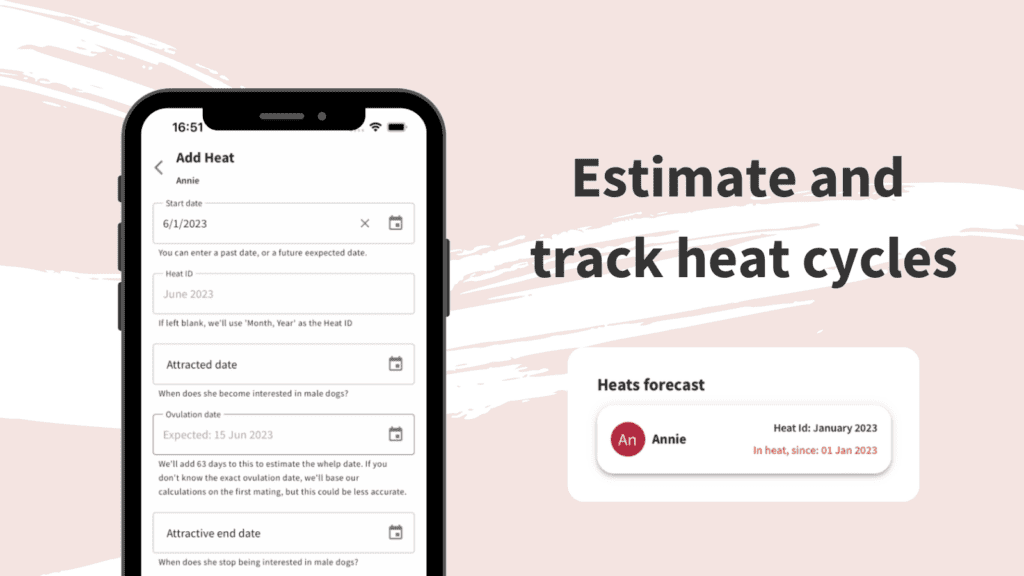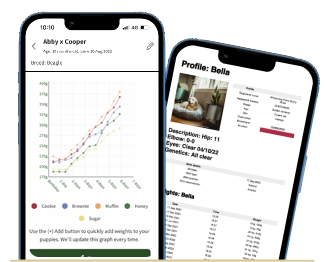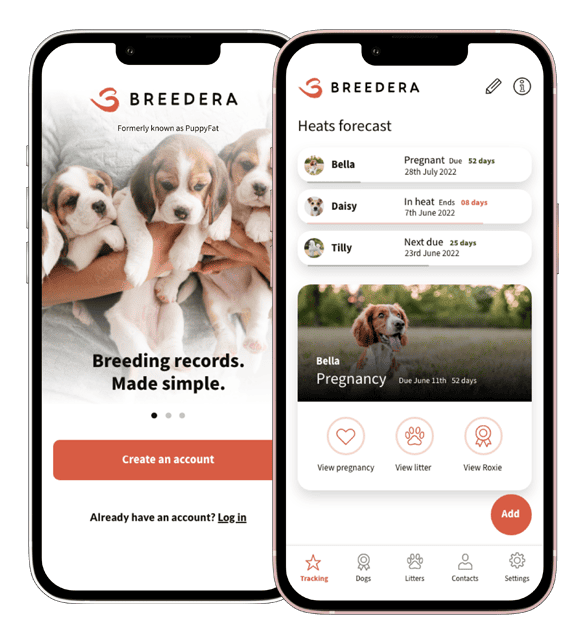In this article
Tracking heat cycles is a crucial part of being a responsible dog breeder. It’s just one of the things that breeders meticulously plan to ensure the health and welfare of their dogs and puppies.
At Breedera, we understand the dedication and passion that drives breeders like you.
By closely monitoring heat cycles, you can unlock a wealth of information that allows you to:
- Plan ahead and prepare your time and resources to ensure a healthy pregnancy and litter.
- Identify the optimal time for breeding, which reduces stress for your bitch.
- Provide appropriate rest periods for your female dogs.
- Prevent unintended breedings and accidental matings.
However, from speaking with hundreds of breeders, we know that tracking heat cycles adds extra admin pressure to your already-busy routine.
Many breeders rely on multiple calendars, massive spreadsheets or mountains of paper files to log heat cycle details and dates. And sometimes, the admin side of things squeezes the precious time that could be spent with your dogs.
In this blog, we delve into the many ways you can track your dogs’ heat cycles in a more efficient and accurate way to ensure the best possible outcomes for your dogs.
What you need to know about tracking dog heat cycles:
Observe the physical signs.
As an experienced breeder, we’re sure you’re well-versed in the physical signs that accompany a dog’s heat cycle.
By carefully watching your bitches, you can quickly identify behavioural and physical changes:
- Behaviour – She’s more friendly or restless than usual.
- Swollen vulva – Her vulva is more pronounced, swollen and red in colour.
- Bloody discharge – Blood spots or stains on her bedding or the floor. This can be typically bloody at the beginning of estrus and becomes more yellow as time goes on.
- Grooming – She may lick her genital region more often than usual.
- Urination – She may urinate more frequently
- Tail position – She may tuck her tail close to her body at the beginning of the cycle, but as estrus progresses, she may hold her tail to one side.
Explore vaginal cytology.
Breeders can gain a deeper understanding of a dog’s fertility with vaginal cytology tracking.
Essentially, it’s a vaginal smear test that can help determine the optimal time for breeding by examining the changes in the types and quantities of vaginal cells present throughout the cycle.
Cytology also has an additional benefit for your dog’s health as it can detect inflammatory and neoplastic conditions in the female reproductive tract.
We spoke with the Breedera Dog Breeding Community and heard back from several members about when cytology is a useful tool:
“I use cytology if I have a girl who is irregular or late coming in, so I can get an idea of what’s going on.”
Another mentions that they offer cytology for their study clients and so far it’s not let them down.
We’d advise you to speak with your veterinarian to find out more about vaginal cytology.
Use progesterone testing.
Progesterone testing is another popular way that breeders use to pinpoint the exact timing of ovulation.
It’s a straightforward blood test that measures the hormone levels in your bitch’s bloodstream, but it can provide invaluable insights into determining the best time for mating and increasing the chances of a successful pregnancy.
When asking members of the Breedera Dog Breeding Community about progesterone testing, several responded with their success stories.
One breeder who uses studs from abroad said progesterone testing allows them to accurately estimate a two-day window before travelling.
Another mentioned being able to pinpoint an exact date of ovulation was important when using frozen semen.
According to the American Kennel Club, the first progesterone test should be done five or six days after you notice any discharge or swelling to establish a baseline. Once progesterone levels begin to increase, you should test once every other day.
Embrace digital.
In today’s digital age, technology offers a wealth of resources to help you when tracking your dog’s heat cycles.
Again, we’ve spoken to many breeders who have set up calendars on their phones and record heat cycle details in spreadsheets.
However, Breedera offers a more streamlined approach; designed specifically for breeders, our app allows you to effortlessly manage your breeding records, track weights, temperatures, heat cycles and more.
You can log previous heat cycles and estimate when she’s next going to be in heat. Upcoming heat cycles appear on your dashboard, so you never miss an important date again.
Planning your next litter is easy with Breedera – you can also record heat cycle details, log behaviour changes, test results, veterinary contact details, stud dog details and mating dates/times to further help you manage the overwhelm of breeding admin.

As a responsible breeder, we know you wear many hats to ensure your dog’s health and wellbeing. Managing your own time, planning ahead and staying on top of breeding admin, as well as looking after your animals can be demanding.
Breedera is here to support you every step of the way, offering a comprehensive platform that simplifies your administrative tasks and allows you to focus on what truly matters – shaping the lives of future pets. Together, we can empower you to achieve your breeding goals, create strong bonds with your dogs, and continue your legacy as a dedicated and successful breeder.
Download Breedera for FREE and start tracking your dog’s heat cycles today.
Sources for tracking dog’s heat cycles:
With special thanks to Tanya Wood and Atiyah Kennel for the image for this article.














By Courtney Farrow
Courtney supports Breedera with all our online content. Specialising in heart-led copywriting for purpose-driven brands, she is passionate about Breedera's mission to make responsible breeding practices easy and rewarding and champion more traceability and transparency in the pet industry.